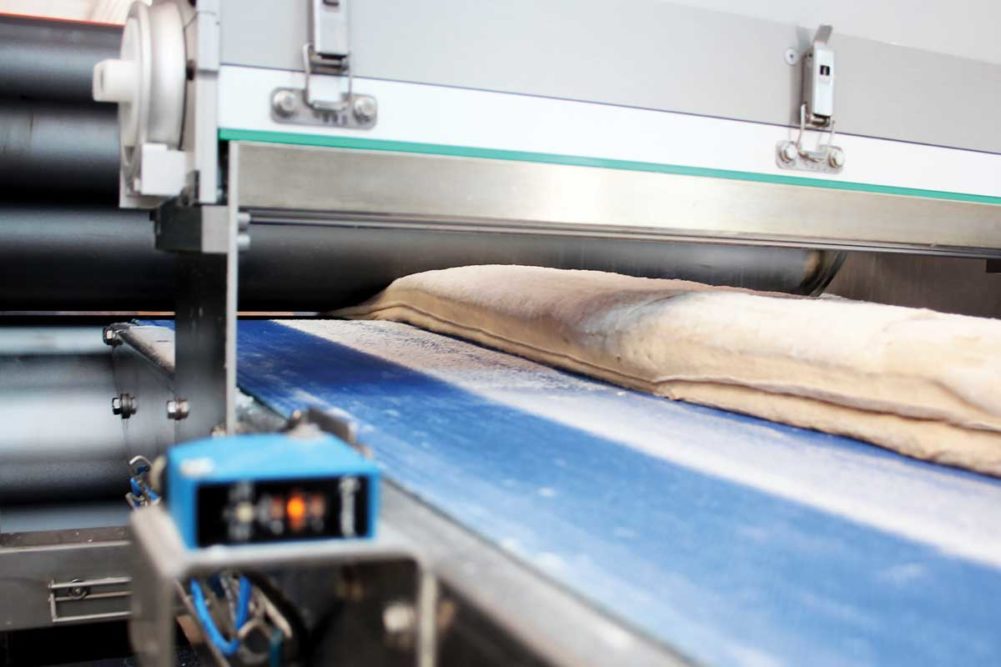Cracker integrity starts with the dough. Ingredients need to be well dispersed and hydrated. Dough temperature needs to be just right. But as Ken Zvoncheck, director of process technology, Reading Bakery Systems (RBS) said, a well-mixed dough can be undone down the line if other parts of the process aren’t optimized. The first place this can happen is the sheeter.
“If we don’t apply even pressure along each reduction, we’re subjecting the gluten to damage, which will cause breakage in the cracker,” Mr. Zvoncheck explained.
The crackdown ratio of this reduction typically falls between 2:1 and 3:1 to prevent this damage from occurring. Any crackdown ratio more than 3:1 will start to weaken the dough. Not only should each reduction station fall within this range of ratios, but they also shouldn’t vary widely.
“The more equal pressure we can put on the dough all the way through, that’s going to be the gentlest crackdown,” Mr. Zvoncheck said. “That’s one of the main causes of broken crackers, assuming the dough is properly developed.”
Cracker dough must be very thin. To reach that goal without damaging the dough, gentle sheeting is in order. For Koenig Bakery Systems, that means modules that gently reduce the dough and provide enough rest time in between each station.
“For Koenig’s Menes dough sheeting line, we recommend including at least two Twin Sat double satellite modules and two to three finishing units, depending on the final dough sheet height,” said Werner Koetz, master baker and baking specialist at Koenig Bakery Systems.
The Twin Sat double satellite head imparts minimal stress on the dough sheet as it’s reduced, producing a virtually tension-free dough sheet. The two satellite roller heads are positioned one above the other, which is how the machine can reduce the high mechanical loads that would be imparted to the dough, damaging the gluten structure.
Rademaker USA works backwards from the final product dimensions to build a sheeting line that can sheet the crackers gently enough without damage. Knowing the final size, weight and capacity helps determine if an extra gauging station needs to be added.
“If you’re talking about thinner crackers or lower absorption crackers, we tend to add additional sheeting heads to ensure the dough sheet is getting reduced properly,” said Nick Magistrelli, vice president, Rademaker USA.
Not only is it important that sheet reduction be consistent from one gauge roll to the next, but it’s also critical for the reduction to be even across the width of the line. As rolls have become larger, the pressure they exude has gotten higher, which can cause separation to occur, wrecking the evenness of the dough sheet.
“When the dough goes under such extreme pressures, especially at the final gauge roll, it’s actually enough pressure to cause the rolls to separate slightly,” Mr. Zvoncheck said. “We’re talking 1/100th of a millimeter that can cause uneven weights across the widths.”
While this may not seem like a significant gap, it causes inconsistencies in the dough sheet, compromising the integrity of the final crackers. Bakers need to keep an eye on these gaps to ensure they are holding steady. Rademaker builds its reduction heads to be more heavy duty and withstand the deflection that can occur on wider cracker lines.
Dough flow control is also critical to ensuring the dough sheet isn’t damaged as it’s reduced. Rademaker features automatic controls on its production lines to ensure dough is flowing in the right direction in a controlled way.
“You don’t want dough stretching or bunching because that relates directly to loss of products or broken crackers,” Mr. Magistrelli explained.
Inclusions can provide crackers with a point of differentiation, visual cues and flavor, but they also can be a weak point in the cracker dough.
While providing texture, nutrition and flavor, these ingredients can also be tricky on the sheeting line.
“The smaller the inclusion the better,” Mr. Zvoncheck explained. “It has to go through the final mid-point without getting stuck; otherwise, it will cause a micro tear in the sheet.”
If bakers insist on larger inclusions for the visual appeal, he suggested adding them with a pressing roller after the dough is reduced to its final thickness.
This article is an excerpt from the November 2020 issue of Baking & Snack. To read the entire feature on cracker technology, click here.






